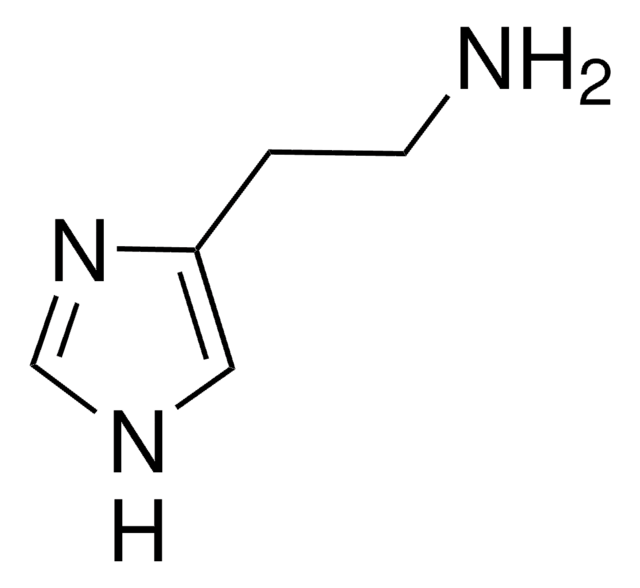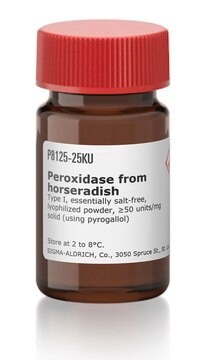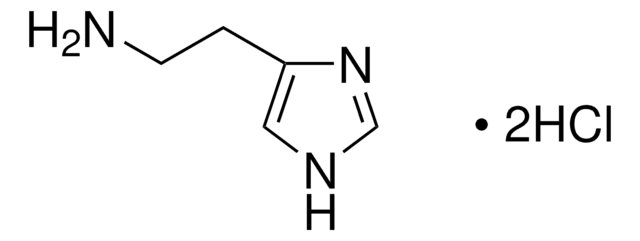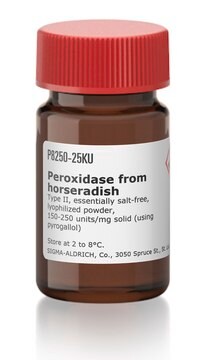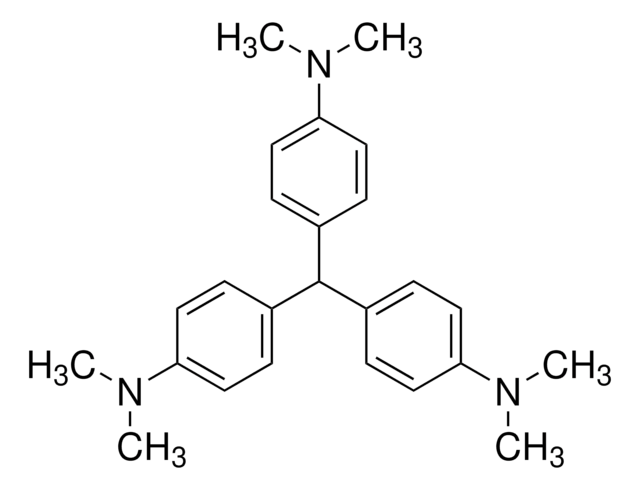Wszystkie zdjęcia(4)
Kluczowe dokumenty
D7876
Diamine Oxidase from porcine kidney
≥0.05 unit/mg solid
Synonim(y):
Amine:oxygen oxidoreductase (deaminating) (pyridoxal-containing)
Zaloguj sięWyświetlanie cen organizacyjnych i kontraktowych
About This Item
Polecane produkty
pochodzenie biologiczne
Porcine kidney
Poziom jakości
Formularz
solid
aktywność właściwa
≥0.05 unit/mg solid
masa cząsteczkowa
170 kDa
rozpuszczalność
100 mM sodium phosphate buffer, pH 7.2: soluble 10 mg/mL
obecność zanieczyszczeń
monoamine oxidase (benzylamine substrate) ≤1%
temp. przechowywania
−20°C
Opis ogólny
Diamine oxidase from porcine kidney is a homodimer consisting of two equal subunits with a molecular weight of 87 kDa each. Each subunit contains one molecule of pyridoxal phosphate and one atom of copper. The molecular mass of the enzyme is found to be 170 kDa. The enzyme is a glycoprotein containing 5% hexose, 3.3% glucosamine, 2.6% N-acetylglucosamine, and 0.25% N-acetylneuraminic acid. The enzyme exhibits a high affinity for concanavalin A. Optimum pH with cadverine and histamine as substrates is found to be 6.3-7.4.
Zastosowanie
Diamine Oxidase from porcine kidney has been used in the construction of histamine biosensor.
Diamine oxidase from porcine kidney has been used in a study to investigate a luminescence-based test for determining ornithine decarboxylase activity. Diamine oxidase from porcine kidney has also been used in a study to investigate N-linked oligosaccharide structures in diamine oxidase.
Działania biochem./fizjol.
Diamine Oxidase catalyzes the oxidation of monoamines, diamines, and histamine to aldehydes, ammonia, and hydrogen peroxide. The enzyme is classified as a copper amine oxidase and it is a key enzyme in nitrogen metabolism. Diamine oxidase is inhibited by diethyldithiocarbamate, phenylhydrazine, semicarbazide, cyanide, isonicotinic acid hydrazide.
Definicja jednostki
One unit will oxidize 1.0 μmole of putrescine per hr at pH 7.2 at 37 °C.
Ta strona może zawierać tekst przetłumaczony maszynowo.
Kod klasy składowania
11 - Combustible Solids
Klasa zagrożenia wodnego (WGK)
WGK 3
Temperatura zapłonu (°F)
Not applicable
Temperatura zapłonu (°C)
Not applicable
Środki ochrony indywidualnej
Eyeshields, Gloves, type N95 (US)
Wybierz jedną z najnowszych wersji:
Masz już ten produkt?
Dokumenty związane z niedawno zakupionymi produktami zostały zamieszczone w Bibliotece dokumentów.
Klienci oglądali również te produkty
A PRELIMINARY INVESTIGATION ON A HISTAMINE BIOSENSOR CONSTRUCTED FROM DIAMINE OXIDASE IMMOBILISED ONTO AN OXYGEN PROBE
The Enzymes (1970)
HISTAMINE BIOSENSOR: A REVIEW
NorazlinaOthman F, et al.
The Malaysian Journal of Analytical Sciences (2006)
Y Wang et al.
Analytical biochemistry, 287(2), 299-302 (2000-12-09)
A sensitive chemiluminescence-based method for the assay of ornithine decarboxylase (ODC) has been developed. This method, which permits the detection of putrescine (the product of ODC) at a picomolar range, can be used to determine ODC activity in cellular extracts.
Diamine oxidase and catalase are expressed in the same cells but are present in different subcellular compartments in porcine kidney.
H G Schwelberger et al.
Inflammation research : official journal of the European Histamine Research Society ... [et al.], 48 Suppl 1, S81-S82 (1999-06-01)
A Rinaldi et al.
Preparative biochemistry, 12(1), 11-28 (1982-01-01)
Several methods for the isolation of apparently homogeneous pig kidney diamine oxidase have been reported in recent years (1-7), but these procedures allow to obtain only little amounts of material making very difficult the study of the molecular properties of
Protokoły
Enzymatic Assay of Diamine Oxidase (E.C. No. 1.4.3.22)
Nasz zespół naukowców ma doświadczenie we wszystkich obszarach badań, w tym w naukach przyrodniczych, materiałoznawstwie, syntezie chemicznej, chromatografii, analityce i wielu innych dziedzinach.
Skontaktuj się z zespołem ds. pomocy technicznej





